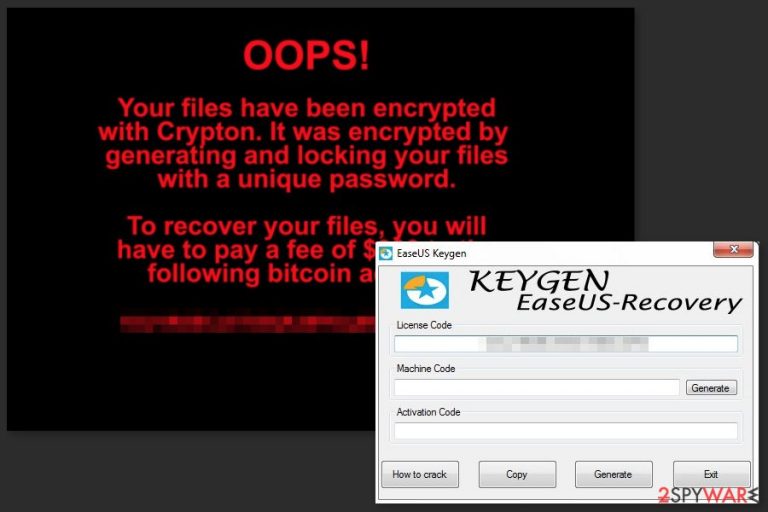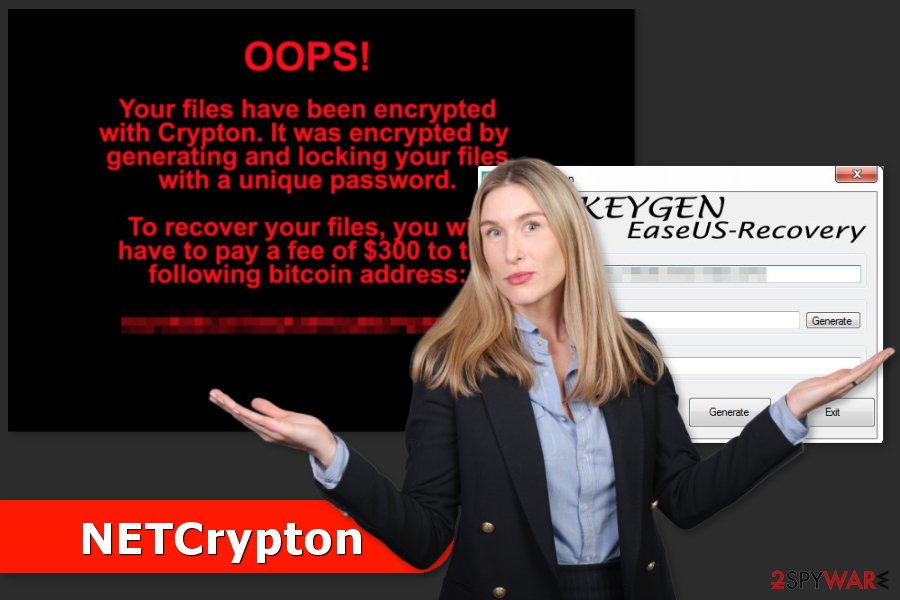NETCrypton ransomware (Decryption Methods Included) - Simple Removal Guide
NETCrypton virus Removal Guide
What is NETCrypton ransomware?
Victims can choose if they want NETCrypton to encrypt their files

NETCrypton is a file-encrypting virus that emerged at the end of November 2017. The malicious program arrives on the system as EaseUS Data Recovery Keygen. It is executed from EaseUSDataRecovery.exe which is dropped on the affected system. During data encryption, it appends .encrptd file extension.
However, NETCrypton ransomware is a strange example of the malware. When the program is launched, it delivers a question: “ARE YOU SURE YOU WANT TO EXECUTE THIS RANSOMWARE?” and allows users to choose between “Yes” and “No” answers. If a victim clicks the latter option, the ransomware[1] is not activated.
Of course, if you choose “No” and prevent malware from encrypting your files, the “keygen” won’t work as well. However, it’s not the biggest problem considering the fact that NETCrypton is actually capable of encoding files. Keep in mind that clicking “Yes” even for fun will lead to data loss. Thus, do not cause yourself problems!
If malware gets a chance to run, it starts scanning the system looking for the popular file types and locks them with .encrptd extension. Once it’s done, NETCrypton delivers a ransom-demanding message. There’s nothing new in the criminal’s word – victims are asked to transfer Bitcoins:
OOPS!
Your files have been encrypted with Crypton. It was encrypted by
generating and locking your files
with a unique password.To recover your files, you will
have to pay a fee of $300 to the
following bitcoin address:[deleted]
Paying the ransom is never an option. Crooks may not give working decryption software and might blackmail you into paying more money. Therefore, if you let ransomware to the system, you should not follow criminals’ orders and just remove NETCrypton from the device.
NETCrypton removal has to be completed using anti-malware software. We recommend using FortectIntego or Malwarebytes for ransomware elimination. However, you can use any other professional and up-to-date security software.

Attempts to get software license keys for free may lead to ransomware attack
NETCrypton spreads as a keygen for EaseUS Data Recovery. Therefore, it might be available to download on various free file-sharing sites or P2P networks. Security experts from No Virus[2] note that cracked programs usually bring malware into the computer. Therefore, you should stay away from illegal software[3] to protect the PC from cyber threats.
However, if the virus evolves, cyber criminals might try other ransomware distribution methods, such as spam email attachments, malvertising or exploit kits. Thus, you should be cautious when browsing the web.
Removal of the NETCrypton ransomware virus
NETCrypton removal should be completed just like any other file-encrypting virus. You need to reboot the computer to Safe Mode with Networking, install legit malware removal program (e.g. FortectIntego, Malwarebytes, SpyHunter 5Combo Cleaner) and run a full system scan. More information is provided at the end of the article.
Hopefully, you have data backups, because currently, they are the only option to restore encrypted files. However, if you do not have them, you can try alternative recovery methods once you remove NETCrypton. Though, chances to restore the majority of files are not high.
Getting rid of NETCrypton virus. Follow these steps
Manual removal using Safe Mode
In order to run automatic NETCrypton ransomware removal, follow these steps:
Important! →
Manual removal guide might be too complicated for regular computer users. It requires advanced IT knowledge to be performed correctly (if vital system files are removed or damaged, it might result in full Windows compromise), and it also might take hours to complete. Therefore, we highly advise using the automatic method provided above instead.
Step 1. Access Safe Mode with Networking
Manual malware removal should be best performed in the Safe Mode environment.
Windows 7 / Vista / XP
- Click Start > Shutdown > Restart > OK.
- When your computer becomes active, start pressing F8 button (if that does not work, try F2, F12, Del, etc. – it all depends on your motherboard model) multiple times until you see the Advanced Boot Options window.
- Select Safe Mode with Networking from the list.

Windows 10 / Windows 8
- Right-click on Start button and select Settings.

- Scroll down to pick Update & Security.

- On the left side of the window, pick Recovery.
- Now scroll down to find Advanced Startup section.
- Click Restart now.

- Select Troubleshoot.

- Go to Advanced options.

- Select Startup Settings.

- Press Restart.
- Now press 5 or click 5) Enable Safe Mode with Networking.

Step 2. Shut down suspicious processes
Windows Task Manager is a useful tool that shows all the processes running in the background. If malware is running a process, you need to shut it down:
- Press Ctrl + Shift + Esc on your keyboard to open Windows Task Manager.
- Click on More details.

- Scroll down to Background processes section, and look for anything suspicious.
- Right-click and select Open file location.

- Go back to the process, right-click and pick End Task.

- Delete the contents of the malicious folder.
Step 3. Check program Startup
- Press Ctrl + Shift + Esc on your keyboard to open Windows Task Manager.
- Go to Startup tab.
- Right-click on the suspicious program and pick Disable.

Step 4. Delete virus files
Malware-related files can be found in various places within your computer. Here are instructions that could help you find them:
- Type in Disk Cleanup in Windows search and press Enter.

- Select the drive you want to clean (C: is your main drive by default and is likely to be the one that has malicious files in).
- Scroll through the Files to delete list and select the following:
Temporary Internet Files
Downloads
Recycle Bin
Temporary files - Pick Clean up system files.

- You can also look for other malicious files hidden in the following folders (type these entries in Windows Search and press Enter):
%AppData%
%LocalAppData%
%ProgramData%
%WinDir%
After you are finished, reboot the PC in normal mode.
Remove NETCrypton using System Restore
System Restore method also helps to disable the virus and get rid of it:
-
Step 1: Reboot your computer to Safe Mode with Command Prompt
Windows 7 / Vista / XP- Click Start → Shutdown → Restart → OK.
- When your computer becomes active, start pressing F8 multiple times until you see the Advanced Boot Options window.
-
Select Command Prompt from the list

Windows 10 / Windows 8- Press the Power button at the Windows login screen. Now press and hold Shift, which is on your keyboard, and click Restart..
- Now select Troubleshoot → Advanced options → Startup Settings and finally press Restart.
-
Once your computer becomes active, select Enable Safe Mode with Command Prompt in Startup Settings window.

-
Step 2: Restore your system files and settings
-
Once the Command Prompt window shows up, enter cd restore and click Enter.

-
Now type rstrui.exe and press Enter again..

-
When a new window shows up, click Next and select your restore point that is prior the infiltration of NETCrypton. After doing that, click Next.


-
Now click Yes to start system restore.

-
Once the Command Prompt window shows up, enter cd restore and click Enter.
Bonus: Recover your data
Guide which is presented above is supposed to help you remove NETCrypton from your computer. To recover your encrypted files, we recommend using a detailed guide prepared by 2-spyware.com security experts.If your files are encrypted by NETCrypton, you can use several methods to restore them:
Use Data Recovery Pro
Data Recovery Pro might help to restore some of the files encrypted by NETCrypton. However, this tool originally is created for recovering files after system wreckage.
- Download Data Recovery Pro;
- Follow the steps of Data Recovery Setup and install the program on your computer;
- Launch it and scan your computer for files encrypted by NETCrypton ransomware;
- Restore them.
Use Windows Previous Versions feature
If System Restore was activated before the ransomware attack and you need to restore only a few files, follow these steps:
- Find an encrypted file you need to restore and right-click on it;
- Select “Properties” and go to “Previous versions” tab;
- Here, check each of available copies of the file in “Folder versions”. You should select the version you want to recover and click “Restore”.
Use ShadowExplorer
If crypto-malware did not delete Shadow Volume Copies of the targeted files, you should try this tool for data recovery:
- Download Shadow Explorer (http://shadowexplorer.com/);
- Follow a Shadow Explorer Setup Wizard and install this application on your computer;
- Launch the program and go through the drop down menu on the top left corner to select the disk of your encrypted data. Check what folders are there;
- Right-click on the folder you want to restore and select “Export”. You can also select where you want it to be stored.
NETCrypton decryptor is not available yet.
Finally, you should always think about the protection of crypto-ransomwares. In order to protect your computer from NETCrypton and other ransomwares, use a reputable anti-spyware, such as FortectIntego, SpyHunter 5Combo Cleaner or Malwarebytes
How to prevent from getting ransomware
Stream videos without limitations, no matter where you are
There are multiple parties that could find out almost anything about you by checking your online activity. While this is highly unlikely, advertisers and tech companies are constantly tracking you online. The first step to privacy should be a secure browser that focuses on tracker reduction to a minimum.
Even if you employ a secure browser, you will not be able to access websites that are restricted due to local government laws or other reasons. In other words, you may not be able to stream Disney+ or US-based Netflix in some countries. To bypass these restrictions, you can employ a powerful Private Internet Access VPN, which provides dedicated servers for torrenting and streaming, not slowing you down in the process.
Data backups are important – recover your lost files
Ransomware is one of the biggest threats to personal data. Once it is executed on a machine, it launches a sophisticated encryption algorithm that locks all your files, although it does not destroy them. The most common misconception is that anti-malware software can return files to their previous states. This is not true, however, and data remains locked after the malicious payload is deleted.
While regular data backups are the only secure method to recover your files after a ransomware attack, tools such as Data Recovery Pro can also be effective and restore at least some of your lost data.
- ^ Paul Rubens. How does ransomware work? Understanding the economics. CSO Online. Security news, features and analysis about prevention.
- ^ No Virus. No Virus. Security news.
- ^ Dancho Danchev. Does software piracy lead to higher malware infection rates?. ZDNet. Technology news, analysis, comments and product reviews.







